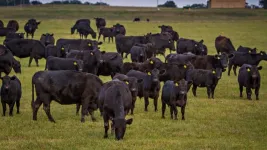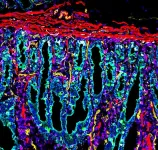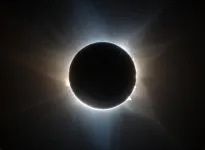(Press-News.org)
The longest nerve in the human body starts in the brain and meanders its way down the neck and into the chest, where it splits into separate branches, winding its twisting tendrils to touch each internal organ. Known as the “information superhighway” and aptly named from the Latin word meaning “wanders,” the vagus nerve is a bundle of fibers responsible for the parasympathetic nervous system: digestion, heart rate, breathing.
Sending electrical impulses down this tenth cranial nerve has proven effective in treating conditions like depression and epilepsy, and it has shown great success in amplifying the effects of motor rehabilitation after stroke. Implanting a device onto the vagus nerve in the neck provides direct stimulation to the information superhighway. And using this technology during post-stroke motor rehabilitation was approved by the Food and Drug Administration as a treatment option in 2021.
But researchers at MUSC have found another method that accelerates treatment outcomes and improves motor function after stroke without this invasive and often-uninsured procedure.
As described in a recent paper from Neurorehabilitation and Neural Repair, the research team placed sensors on the upper arm and in the ear and used the connected computer to send timed electrical impulses to the vagus nerve during motor rehabilitation. This noninvasive VNS method, known as motor activated auricular vagus nerve stimulation (MAAVNS), allows patients to gain the same amount of motor function improvement in 4 weeks that patients with the implanted device reached in 6 weeks – all without surgery.
MAAVNS was developed and is currently pending patent at MUSC.
Stroke is a leading cause of disability in the United States according to the American Stroke Association, and it leads to motor deficits and reduced mobility in almost half of stroke survivors over the age of 65. With such a large number affected, Bashar Badran, Ph.D., the director of the Neuro-X lab and Computational Brain Imaging Core at MUSC as well as the principal investigator on the paper, wanted to find a more accessible way to help patients recover.
“Motor rehabilitation is time-consuming and expensive, and oftentimes does not produce the results that patients want,” said Badran. “Technology like the MAAVNS system can boost the effects of conventional motor rehabilitation and help patients get the most out of their therapy in a simple and relatively inexpensive manner. It’s very exciting.”
With a small cart containing the computer and sticker-like sensors, the MAAVNS system can easily be incorporated into occupational therapy settings, with little change or impact to the current standard of care.
With hundreds of repetitions in an hour, patients can focus on specific movements they want to improve, like sewing, cutting fabric or buttoning a shirt, while the MAAVNS system detects when the patient is moving and intricately delivers electrical stimulation to nerves in the ear.
Badran says delivering the stimulation in conjunction with each movement is critical. “Our work shows that outcomes are much better when you time the stimulation in conjuction with movement, in a closed-loop approach,” he said. “Interestingly, more stimulation is not better. In fact, less stimulation timed correctly produces the best outcomes.”
Since the vagus nerve elicits brain activity in areas responsible for the release of neurotransmitters like norepinephrine and serotonin which help the brain learn, stimulating it with electricity facilitates faster learning of motor skills.
While the sample size for this pilot study was small, Badran and his team will be conducting a larger clinical trial next to further study the effects of this noninvasive VNS technique. “This is really promising technology,” Badran said. “And the fact that the outcomes are mirroring what is already FDA approved is great. Not only do we believe this is an effective new technology for post-stroke motor rehabilitation, but it’s cheaper and easier to incorporate into the standard of care than what is currently available.”
###
About MUSC
Founded in 1824 in Charleston, MUSC is the state’s only comprehensive academic health system, with a unique mission to preserve and optimize human life in South Carolina through education, research and patient care. Each year, MUSC educates more than 3,000 students in six colleges – Dental Medicine, Graduate Studies, Health Professions, Medicine, Nursing and Pharmacy – and trains more than 850 residents and fellows in its health system. MUSC brought in more than $327.6 million in research funds in fiscal year 2021, leading the state overall in research funding. MUSC also leads the state in federal and National Institutes of Health funding, with more than $220 million. For information on academic programs, visit musc.edu.
END
The formation of the country’s first emergency department for the over 80s led to a significant decrease in time spent in A&E – according to research from the Norfolk and Norwich University Hospital (NNUH) and University of East Anglia (UEA).
The first Older People’s Emergency Department in England was opened at NNUH in December 2017 to bring specialists in older people’s medicine to the front doors of the hospital and provide earlier assessment and treatment for patients.
A new study evaluates the outcomes for patients who received treatment in the main emergency department at NNUH and a similar ...
Have you ever wondered why some people never became sick from COVID-19? A study published today in Nature shows that common genetic variation among people is responsible for mediating SARS-CoV-2 asymptomatic infection. The results indicate that individuals having this variant never feel sick once infected. This exciting discovery was a result of a U.S.-Australia collaborative work led by Danillo Augusto, Ph.D., assistant professor at the University of North Carolina at Charlotte; Jill Hollenbach, Ph.D., professor ...
Nearly a century ago, physicists Max Born and J. Robert Oppenheimer developed an assumption regarding how quantum mechanics plays out in molecules, which are comprised of intricate systems of nuclei and electrons. The Born-Oppenheimer approximation assumes that the motion of nuclei and electrons in a molecule are independent of each other and can be treated separately.
This model works the vast majority of the time, but scientists are testing its limits. Recently, a team of scientists demonstrated the breakdown ...
Women with Lyme disease take longer to get diagnosed, have more severe symptoms and experience higher rates of disability when compared to men. They may also be more likely to develop persistent Lyme disease. Those are among the findings of a recent study that analyzed information from the MyLymeData patient registry. The results have been published in the International Journal of General Medicine.
The present study, which was conducted by LymeDisease.org, a research and advocacy organization, assessed sex-based differences in Lyme disease patients who remained ill for six months or more after antibiotic treatment. In ...
Ranches across the Show-Me State manage approximately two million cattle — a significant number of which are Angus, a top-tier breed that has unrivaled success in the commercial beef market. In a new study, University of Missouri researcher Jared Decker and Thompson Research Farm tested a group of commercial Angus cows using a commercial genomic prediction tool called Zoetis GeneMax Advantage to investigate the ability of the test to predict their calves’ performance and profitability. This project demonstrates ...
COLUMBUS, Ohio – Immune system changes in the pregnant body that protect the fetus appear to extend to the brain, where a decrease in immune cells late in gestation may factor into the onset of maternal behavior, new research in rats suggests.
In adult female rats that had never given birth – which typically don’t like being around babies – depletion of these cells sped up their care for rat newborns that were placed in their cage.
The loss of these cells, called microglia, and the related uptick in motherly attentiveness were also associated with changes to neuron activity in several regions of the rat brain, suggesting ...
Early in pregnancy, something strange happens in the uterus: Cells from the fetal side of the developing placenta invade the uterine endometrium and work with the mother’s immune system to remodel the arteries.
“When I first read about it, I thought, ‘This is so bizarre,’” said Stanford Medicine pathologist Michael Angelo, MD, PhD.
Humans’ immune systems usually attack unfamiliar cells, which would theoretically pose a problem for a developing pregnancy. But on the mother’s side of the growing placenta, the arteries incorporate cells that genetically match the embryo, just one of ...
When you think about your ideal neighborhood, perhaps you think of tree-lined streets or a close-knit community of people who help each other. You probably don’t think about your digestive system.
But maybe you should. According to a team of scientists led by researchers at Stanford Medicine, there are indeed “neighborhoods” of different cell types cooperating to digest your food and protect you from infection, among other things — and a new, ultra-high-resolution map of these neighborhoods proves your intestine is both functionally impressive and visually striking.
Just like human neighborhoods, ...
The incidences of teen suicidality including self-harm, suicidal ideation, and suicide attempts increased nationally between 2016 and 2021; were at seasonal high peaks in April and October; and were at their lowest when schools were shut down during the COVID-19 pandemic, according to research at UTHealth Houston.
The study was published this month in JAMA Network Open. It was authored by Youngran Kim, PhD, assistant professor in the Department of Management, Policy, and Community Health at UTHealth Houston School of Public Health; Scott D. Lane, PhD, professor and vice chair for research in the Louis A. Faillace, MD, Department of Psychiatry and Behavioral ...
NASA has awarded funding for three science teams to conduct citizen science investigations as a total solar eclipse sweeps across North America on April 8, 2024. In these experiments, volunteers will help study the Sun and its ethereal outer atmosphere, called the corona, which is revealed when the Moon completely covers the Sun’s bright disk.
“During next year’s total eclipse, hundreds of volunteers will capture images of the Sun and its corona to help answer real science question about our star and how it affects us,” said program scientist and eclipse lead at NASA Headquarters, ...




